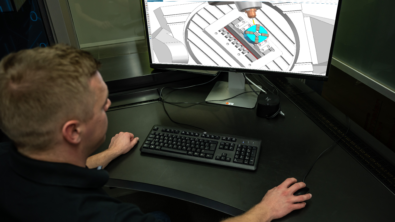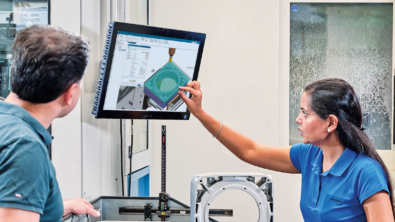NX helps turbine blade manufacturer reduce production steps by 60 percent
“Before NX, we would spend on average three days generating NC paths after an adaptation of the design. Thanks to the integration of NX, this is now done in half and hour.” Gerrit Mulder, Engineering Manager, Stork Turbo Blading BV
A worldwide market
Turbines for energy generation are precision machines whatever their scale. The blades wear out while in use and must be replaced as quickly as possible. Down time is expensive. Stork Turbo Blading BV specializes in producing turbine blades for which high precision, quality and short delivery times determine the success of an order. Based in Sneek, Netherlands, Turbo Blading is part of the Stork Power Services division of the industrial Stork Group. The company caters to a worldwide blade market, supplying OEMs as well as the service and aftermarket sectors.
Turbines that are used in energy generation can be applied in multiple venues, including coal-fired power plants, small installations that generate electricity on a ship or even in heat recovery facilities. The broad range of turbine dimensions, from 50 to 1200 mm, illustrates how flexible Stork Turbo Blading has to be to meet its clients’ needs.
The other business units in the Stork Power Services Group include Stork Thermeq, which specializes in boilers and burners; Stork Turbo Service, which installs and maintains turbines; and Stork Gears and Services, which supplies and maintains gear boxes. As a group, Stork Power Services provides operators of energy generation installations with a full range of services.
“Turbine blades wear during their service life,” explains Gerrit Mulder, engineering manager at Stork Turbo Blading. “Wear is determined by how they are used. Even water has a destructive effect. The blades of both the stationary and the rotor steps of the turbine sustain damage. This leads to a drop in efficiency while posing a risk that can cause a possible imbalance.”
The fatigue and wear of bearings and seals are other reasons to service a turbine. The Stork Power Services Group overhauls aircraft engines and other systems in addition to overhauling steam and gas turbines.
The process behind 80,000 blades annually
Large numbers of blades often are involved when carrying out revisions. An installation in a power plant with two turbines of 15 steps, each with 120 blades per step, requires 3,600 blades. Each differs from step to step. “On a yearly basis we produce 80,000 blades that can vary a lot in dimension,” explains Mulder. “We do that with 11 engineers, six quality assurance specialists and 40 production staff, who generally work in two shifts and even three at times. But in spite of our significant manpower, we never would have been able to reach this production and the level of quality if we had not figured out better working methods for engineering, work preparation, production and the associated tooling.”
By tooling, Mulder is not just referring to the 4-axis and 5-axis milling machines owned by Stork Turbo Blading. “The real advantage lies in the efficiency of the process before the data goes to the machines,” Mulder says. “And this process can only be achieved with the right software.”
An order usually starts by recording blade damage. This is done to determine which steps in the turbine blades need to be replaced. In three-quarters of the cases, once this has been established, scanning technology is used to determine the exact shape of the blades. “In these instances, no drawings of the blades are available,” says Mulder. “The blades are scanned in on-site by a designated partner. Operating on a worldwide basis, this partner also converts the point cloud resulting from the scan to STEP geometry. We compare this data with the data of blades that we have already produced. It is quite possible that we have produced the blade before. Our database contains drawings showing cross-sections with measurements and shape tolerances.”
The best software
Stork Turbo Blading uses NX™ software, including NX CAM, to engineer the blade and generate NC paths. “We have been using NX for seven years now,” Mulder says. “In 2002, we compared the most important players in a pilot project. NX came out of it unquestionably as the best product. It fits within our organization. The functionality is what we want. And the applicability to our products is very good.”
Mulder notes that it is important that multiple engineers be able work on a design simultaneously. Based on the STEP model, the base and blade are developed separately because they are two distinct parts of the product. According to Mulder, “We also find it important to be able to develop the fixtures in parallel. This is possible thanks to the NX working method based on a ‘master model.’ In addition, the perfect integration between CAD and CAM ensures that modification cycles become extremely short.”
For the company’s engineers, the scan is the absolute reference when developing the NX model. In this process, the locations where the milled product must be measured are indicated with precision. Step-by-step instructions are issued for production.
Mulder explains the positive impact of NX on the process: “Where we used to have 12 steps in the production process, there are now only five – cutting, base milling, blade rough-milling, blade finish-milling and sometimes blade cutting off. The 4-axis milling machines, which are widely automated with pallet systems, mainly mill the base and rough-mill the blade leaf. All four axes are used simultaneously in these processes. Finish-milling takes place in a 5-axis simultaneous milling process.”
From 3 days to 30 minutes
Mulder quantifies the value of NX on the CAD and CAM integration: “Before NX, we would spend on average three days generating NC paths after an adaptation of the design. Thanks to the integration of NX, this is now done in half an hour. However, time saving is not the only benefit. The risk of errors is lower because the generation of NC paths is almost an automatic process.”
Before the blades can be shipped and assembled, each blade undergoes a quality check. Among its various aspects, the quality plan includes geometrical control and a crack-detection test. The definition of the performance indicators in NX is transmitted to the measuring device to ensure that measuring the blades takes place automatically for the most part. All of the blades are also subjected to a magnetic test to detect potential cracks in the material. Each step in the turbine gets its own report and material certificates. Some turbine blades are also weighed.
“We use a special program to distribute the sections of the blades on the turbine disc,” Mulder explains. “Minimum weight differences between the blades are inevitable and can create an imbalance, which needs to be rectified during installation by balancing the turbine disc. Calculating the distribution of the blades based on their weight results in considerably less work during the balancing stage.”
NX – the right choice
After seven years, Mulder remains convinced that the company made the right choice. “Without NX, we would not have been able to offer our current level of service and, as a result, today’s business would not be possible. The simplified production process and the fast processing of modifications have led to a faster overall process and higher quality. In short, NX has played a major part in our company’s success and will continue to do so.”
Client’s Primary Business:
Stork Turbo Blading provides a wide range of high-precision blades for steam turbines, gas turbines, axial compressors, expanders and turbo chargers. The company also handles the manufacturing of labyrinths for steam turbines and centrifugal compressors.



